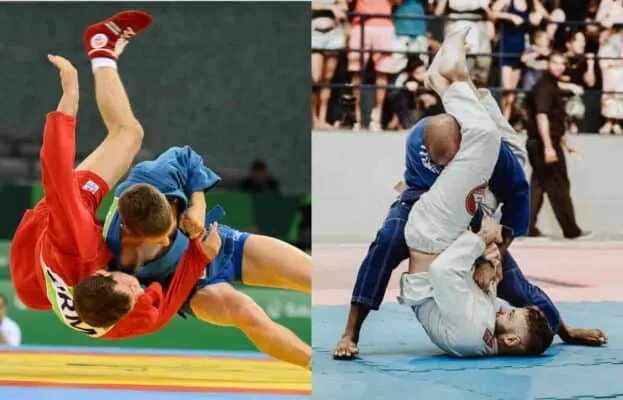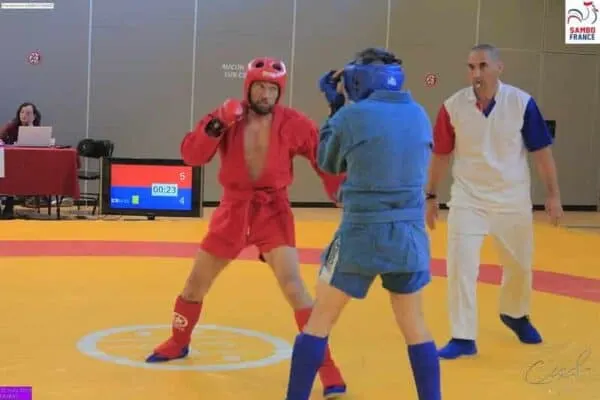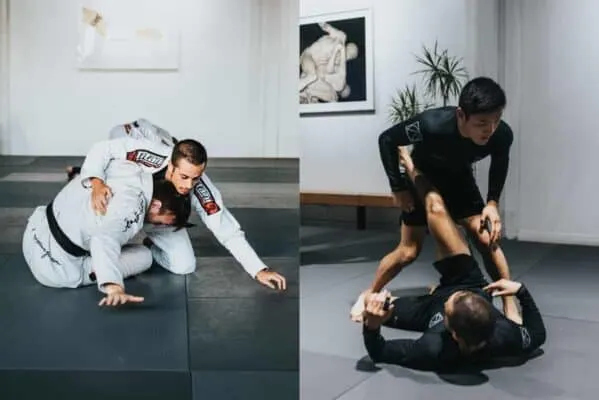
Sambo and Brazilian Jiu-jitsu (BJJ) are two separate martial arts that emphasize the same aspect: grappling. Though similar in some areas, these two systems differ a lot in various aspects such as origins, techniques, objectives, and rules. That being said the ultimate question is, which martial art is better? Here’s a short and sweet answer.
Sambo is much better than BJJ when it comes to preparing you to become a complete fighter. Sambo will teach you how to fight both on the ground and standing up using strikes, whereas BJJ only prepares you to fight on the ground without any striking.
Thus, in theory, Sambo works better in various self-defense scenarios that you may face on the streets as it also incorporates weapon training. It is a mix of striking, grappling, and ground fighting techniques put into one martial art. Very much similar to modern MMA fighting.
BJJ focuses entirely on grappling and it is more advanced when it comes to pure ground fighting. It is also more accessible, and much safer to train in since there’s no striking.
This is just the tip of the iceberg when it comes to these two martial arts. Thus, be sure to read the rest of the article to learn more about how these two are different from each other when compared and which one is better in which situation.
Comparison of Sambo and BJJ
Concept and emphasis
Sambo was originally developed for the Soviet military as a means of unarmed combat in the 1920s. It was designed for real combat where the main goal is to quickly neutralize the enemy. Practitioners of Sambo carry this aggressive approach both in a self-defense scenario and in competition. Sambo was not initially created to be a sports martial art, despite having a sports version in later years.
The concept and training methods revolve around techniques from various martial arts such as:
- All styles of wrestling (folkstyle, freestyle, Catch wrestling etc)
- Judo and Japanese jujutsu
- Karate, western boxing, taekwondo, thai boxing
BJJ is a self-defense martial art developed by the Gracie family in the 1920s. Most of its techniques come from judo, with the emphasis being on takedowns, throws, and advanced ground fighting. The modern practice is oriented more toward competition and teaching you how to win matches.
Styles
There are two main styles of Sambo: Sport Sambo and Combat Sambo.
- Sport Sambo —Many of its moves are derived from Judo and wrestling. This version is all about grappling on the ground. There are no chokeholds or striking.
- Combat Sambo — This style was designed mainly for self-defense purposes and is used by the Russian military. Combat Sambo looks similar to MMA fighting where fighters can use punches, elbows, kicks, and knees as well as groin strikes, head-butts, or soccer kicks. When the fight goes to the ground, sambo practitioners learn how to apply the various submission moves you see in BJJ. This form also incorporates some basic weapon-based training.

Photo by CFS SAMBO FRANCE / CC BY-SA 2.0
There are three main styles of jiu-jitsu:
- Brazilian Jiu-jitsu (BJJ)—focuses on the sporting aspect of Jiu-jitsu. BJJ students learn how to grapple with other students in a structured, rule-based environment.
- Gracie Jiu-jitsu —is designed for self-defense and has more elaborate techniques than BJJ. There is no competition or rules to follow, and it all revolves around real-life self-defense situations.
- No Gi Jiu-jitsu— is a style where athletes do not wear a Gi uniform in training and competition. They also tend to perform at a much higher pace than the ones in a Gi style due to less friction.

Techniques and Weapons
Sambo is a versatile system that allows all styles of takedowns from all styles of wrestling and trips and throws from judo. It trains you to strike using all limbs with kicks, punches, knees, and elbows. On top of that, it includes bone-breaking joint locks and chokes. However, heel hooks, wristlocks, neck cranks, and spine locks are not allowed in competition.
Here is a list of major BJJ techniques:
- Wrestling takedowns (single/double leg, ankle pick, low double)
- Judo throws (outer reap, hip throw, shoulder throw)
- Positions (side control, back/full mount, half-guard)
- Joint locks (kimura, knee bar, armbar)
- Chokeholds (D’arce, rear-naked choke, guillotine choke)
Objectives in a match
Combat Sambo is an explosive style where athletes are more aggressive in their approach since the matches are quite short (5 min). The key is to pin the opponent down fast (to win points), finish the match with any type of chokes and joint locks, or knock them out. In contrast with BJJ, positions and guard do not play a big role at all, as the focus is on pins. Striking is important, but not as much as grappling mainly because striking is not awarded any points.
BJJ is a bit more strategic and the action is much slower. The goal is to take the opponent down, securing a dominant position to win points, or finishing the match with submission moves. Compared to sambo, BJJ athletes are more strategic and patient in their approach. There are no points for pins as the focus is on securing a dominant position.
Rules of competition
Sambo rules are very similar to MMA rules:
- Match duration: 5 minutes in an 8-meter ring.
- Outcome of the match: Decision, knockout, submission, disqualification
- Equipment: red/blue sambovka uniform, open-fingered gloves, shoes, gum shield, groin cup.
- Point System:
- Fighters can win the match via submission(armlock or leglock)
- The fight ends when there’s an 8-point difference between the two fighters.
| Techniques | Points Earned |
| Throws the opponents on their back while the attacker is standing | * Wins a match |
| Throws the opponent on their back and the attacker ends up on the ground | 4 |
| Throws the opponent to the side while the attacker remains standing | 4 |
| Throws the opponent to the side and the attacker ends up on the ground | 2 |
| Throws the opponents onto their chest, buttocks, or shoulder while standing | 2 |
| Throws the opponents onto their chest, buttocks, or shoulder and the attacker ends up on the ground | 1 |
| Attacker holding down the opponent on their back while pressing them torso to torso for 20 seconds | 4 |
| Attacker holding down the opponent on their back while pressing them torso to torso for at least 10 seconds | 2 |
BJJ rules:
- Match duration: white belts: 5 minutes, blue belts: 6 minutes, purple belts: 7 minutes, brown belts: 8 minutes, black belts: 10 minutes
- Outcome of the match: Decision, submission or disqualification
- Equipment: A gi uniform and a rank belt around the waist, or rashguard for No-Gi.
- Point System:
| Techniques | Points Earned |
| Full Mount | 4 |
| Back mount | 4 |
| Take the back | 4 |
| Guard passing | 3 |
| Takedown | 2 |
| Knee on belly | 2 |
| Sweep | 2 |
What are the key differences between Sambo and BJJ?
The key differences between Sambo and BJJ that differentiate the two fighting styles are as follows:
- Sambo utilizes wrestling techniques, while BJJ does not include any wrestling techniques.
- Sambo does not allow chokeholds but BJJ allows chokeholds.
- Sambo(combat version) has striking and dirty moves such as soccer kicks, but BJJ has no striking and no dirty moves.
- Sambo was developed for the Russian military as a hand-to-hand combat system, while BJJ was developed for all people to defend themselves.
Sambo was created for the Russian military to improve their hand-to-hand battle skills to neutralize their threats quickly in a tense situation. BJJ was created for everyone to learn how to defend themselves on the ground using submission moves in a more relaxed environment with rules.
Which one is better for self-defense (street fight)?
On paper, Sambo is a better option as it is more in line with the type of freestyle combat you may face in real life. It is more versatile than BJJ in terms of weapons, covers more scenarios, and overall, its aggressive approach is more practical. Here is a look at the pros and cons of both arts:
| Pros and cons of Sambo | Pros and cons of BJJ |
| Pros: All-around system Prepares you for any fighting scenario Highly realistic training Focus on finishing the fight quick. Cons: Not popular outside of Russia | Pros: Very practical techniques A lot of sparring Allows you to win a fight without causing injuries. Cons: No striking or self-defense training |
BJJ is one of the best martial arts for self-defense. Just look how dominant its fighters are in MMA if you need any proof. It matches well against other styles, notably against aggressive people who are not trained in martial arts. It allows you to neutralize the attacker in the most efficient way possible, and above all, without any injuries. Just a takedown and a dominant position are often more than enough to subdue the attacker.
But Combat Sambo is even more effective. It will teach you very much the same takedown techniques, and good enough ground fighting skills. But on top of that, it adds advanced full contact striking with all limbs, and even dirty tactics. Yes, as a military system, it includes dirty moves as well as some basic weapon-based training.
Sambo vs. BJJ – Which is better for MMA?
The only fair answer is that both sambo and BJJ are equally important in MMA. On one side, Combat Sambo as a concept shares a lot in common with MMA and fits better within the rules. But BJJ is the king when it comes to ground fighting, which is perhaps the most important segment of the game. Here are the pros and cons:
| Pros and cons of Sambo in MMA | Pros and Cons of BJJ in MMA |
| Pros: Fits better within the rules Covers most of the elements of MMA Explosive striking and takedowns Cons: Not as advanced on the ground as BJJ | Pros: Most effective on the ground Advanced positions and submissions Hard to defend against Cons: The lack of striking and offensive wrestling |
MMA is a hybrid martial art that enables fighters to strike using all limbs, grapple in the clinch, take each other down, and fight on the ground. Though not as present as BJJ, Sambo is one of the few martial arts that covers all the elements of MMA. It is a mix of only the most effective techniques from various arts such as wrestling, boxing, judo, jujutsu, and karate, which makes it close to ideal for MMA.
BJJ skills are crucial when it comes to ground fighting, even superior to Sambo. But it is clearly limited due to its emphasis on one element and lack of striking, and maybe explosive wrestling. Still, don’t expect to succeed in MMA without training jiu-jitsu, even if you are the best sambo fighter in the world.
The final answer is: Combat Sambo works better in MMA. However, upon switching to cage fighting, all fighters need to spend a lot of time training in BJJ to improve their game. Among many other skills, they must develop better positioning skills and learn how to work from guard.
| Famous Sambo fighters in MMA | Famous BJJ Fighters in MMA |
| Khabib Nurmagomedov Fedor Emelianenko Yaroslav Amosov | Charles Oliveira Fabricio Werdum Royce Gracie |
Sambo vs BJJ – Who would win in a fight?
At first sight, it might look like Sambo is superior as it is designed for real combat and is more versatile when it comes to weapons. But fighting on the streets has an infinite number of variables and possible scenarios, including the ones in which BJJ has an edge. Still, no one could argue against the fact that sambo fighters have an advantage in a 1 vs. 1 type of fight.
Here are the key advantages Sambo fighters have:
- Puts more emphasis on pure self-defense training
- Includes more weapons and covers more scenarios
- More explosive and aggressive approach
- Far more superior on the feet because BJJ does not teach you striking
- Great takedown defense and BJJ fighters would have a really hard time scoring takedowns
First of all, fighters trained in Sambo are more aggressive and violent in their approach. They are trained to swing shots with full power, score powerful takedowns, and chase a finish from the opening second due to its heavy emphasis on finishing the fight straightaway. They might surprise and overwhelm the BJJ fighter with their explosive approach, athleticism and high pace. But the key advantage is a mix of solid striking skills and great takedown defense.
BJJ fighters would be in a world of trouble because they won’t be able to take the fight to the ground at their will. No, Sambo fighters all have top-level defensive wrestling, and they are the ones in this matchup who decide where the fight takes place. If they want, they might keep the fight standing and destroy them with long-range kicks and punches. They surely have better boxing and kickboxing skills.
The only advantage BJJ has is if the fight goes to the ground. They have better scrambles and are far superior when it comes to positioning and catching Sambo fighters into submission.
RECOMMENDED READING: Muay Thai vs. Boxing – Who Would Win and Differences Explained
Which one is harder to learn?
On paper, Combat Sambo is harder to learn as it is a more versatile martial art. But there are also aspects of learning in which BJJ might be even harder. Here is a closer look:
More techniques — Sambo
As explained, Combat Sambo is a mix of striking and grappling techniques from various martial arts. Thus, it takes time to learn all of the techniques and develop coordination and balance to mix it all together. BJJ might have fewer techniques on paper but bear in mind that each move has an infinite number of variations.
Takes more time to learn — both
Yes, Sambo might be more versatile and with that, harder to learn. But the only fair answer is that both take up to 10 or 15 years to master. Depending on the school, do not expect to reach the highest rank in these two systems in less than 10 years.
More intense — Sambo
As a system designed for military and real combat, Sambo is far more intense. Right from day one, you will learn how to unleash your violent instincts as soon as the fight starts. Classes are intense, include a lot of full contact sparring, and it is much harder on your body. BJJ is also called a “gentle” martial art due to the importance of strategy and a methodical approach to fighting. It teaches you to stay calm, take your time, be patient, and wait for the perfect time to attack.
Safer to train in — BJJ
BJJ is one of the safest martial arts and the injury rate is 9.2 injuries per 1000 exposures of playtime. The main reason is the fact that there are no strikes, which are often the main cause of most injuries.
Which martial art is better for you?
This is an individual question and the answer is based on your personal end goals. Both of these martial arts share similar benefits when it comes to real combat, fitness, and health benefits.
But one important factor to consider here is that Sambo is not that popular outside of Russia or former Soviet Republics. You might have a hard time finding a school to train in if you live in Western Europe, the US, or South America. Even if you are lucky enough to find one, the quality of classes and coaching staff might not be the same as in Russia.
If you want to learn how to become a complete fighter, there is no doubt that Sambo is a much better option for you if you can find a good Sambo school in your area. Sambo is more versatile than BJJ, covers more scenarios, is more practical overall, and works much better in MMA as well.
If you are not interested in learning full combat skills, just start with BJJ. BJJ focuses more on building character and helping you grow into a person with good manners and exceptional grappling skills. It is very adaptable as it allows you to approach it your way and learn at your pace and according to your abilities. Thus, this makes it a far better option for beginners and amateurs who want to practice and learn martial arts at their own pace.
